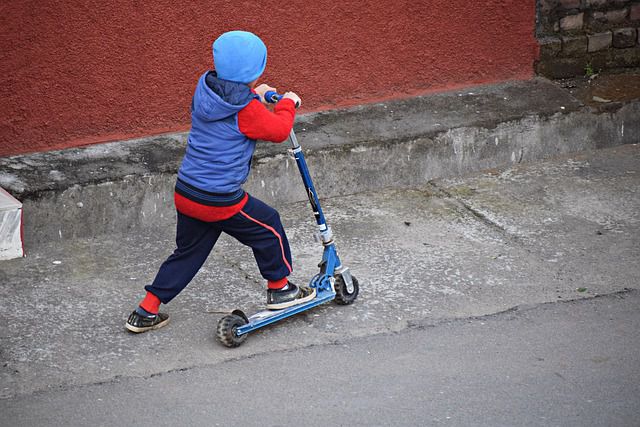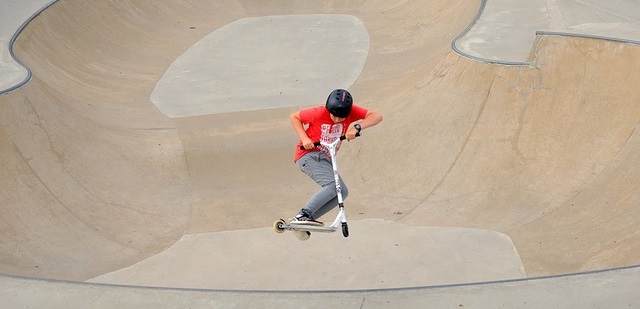The kick-scooter (also called a scooter or push-scooter) is a street vehicle equipped with the handlebar, deck and wheels that are driven by a driver pulling off the ground using their legs. Nowadays, the most popular scooters are made from titanium, aluminum and steel. A few kick scooters that are designed for youngsters have 3-4 wheels (but the most popular ones come with two wheels) and are constructed of plastic, but they don’t fold. The high-performance kickbikes are also made.
Early scooters
The kick scooter has been made in urban industrial areas of Europe as well as the United States since the 1920s or even earlier, mostly as toys for kids to play on through the streets. A common version made at home is constructed by affixing roller skate wheelsets to a board that has the help of a handle, typically an old wooden box. The skaters can turn by leaning and turn, or use another board that is connected to the simple pivot. The building was entirely made of made of wood, with 3-4 inches (75-100 millimeters) wheels that had the ball bearings of steel. A further benefit of this type of construction was the noisy sound that was akin to in the “real” vehicle. A different construction is one steel clamp mounted on an ice skate that is split in two parts: the front and rear and a wooden beam.
Kick scooter
In 1974 in 1974, the Honda company launched the Kick ‘n’Go the first scooter to be driven by a pedal that was attached to lever. Although it was not the same effort for a “kick” as a regular scooter however, its novelty was noticed and it soon gained popularity.
Pneumatic tires
Prior to the time that bicycles became popular with children, scooters made of steel with two bicycle wheels were more popular. In the year 1987, several BMX manufacturers made similar scooters to BMX like Scoot.Those companies stopped making scooters, however some scooter manufacturers emerged in the later times and are still operating; others are still in use in urban regions for practical reasons, because they’re more efficient than folding scooters and much more comfortable than a bicycle for utility purposes. Certain models are designed for off-road usage and are referred to as mountain bikes. Apart from the need to commute, compete in sports and off-road usage, the large-wheeled models are also popular for dog-scooting which is a sport in which teams of dogs, either single or like huskies, drag an unicycle and its driver similar to how the sled is driven across snow. A few Amish do not have the right to use bicycles, and so they take scooters instead.Today there are variations of the kicksled that have scooter-like options are also available, including the Kickspark.
Kickbike
The invention of the kickbike Finland in 1994 altered the way scooters are perceived. The Kickbike features a front wheel that is standard in size and a smaller rear wheel that makes for the ride to be much more efficient. It is the Footbike Eurocup has been held since 2001.
Folding scooters
In the year 1996, a folding aluminum scooter with skates inline wheels was designed by Wim Ouboter from Micro Mobility Systems in Switzerland. The scooter was marketed in the form of “Micro Skate Scooter,” “Razor,” and “JDBUG/JDRAZOR MS-130A”.The Razor was introduced to Japan in 1999, with the initial users having been young Japanese who utilized it for transportation on the go. It then became a world-wide trend and small scooters became the most popular toys for kids.
Pro scooters
The kick scooters that are used for extreme sports and tricks, and designed to withstand the rigors of stress and frustration they are referred to as pro scooters. Many brands offer stunt scooters as well as accessories like helmets and pegs, grinding wax griptape clamps and clothing.
Three wheels
Three-wheeled scooters that resemble tricycles have been developed for young children.
In 1999, Micro Mobility Systems and K2 Sports produced a reverse-three-wheeled scooter called “Kickboard.” Micro also made children’s scooters that resembled the Kickboard “Mini Micro” and “Maxi Micro.” The reverse design provides more stability over the standard design: A person who is standing will prefer to sit at the front of the scooter, instead of the rear. But the steering geometry isn’t strong and needs modifications to design in order to enhance its responsiveness. A good illustration of this is called Mini Micro, a model Mini Micro, which uses spring-loaded systems to translate the lateral force of the bar (child being leaning) into a turning movement on the wheels and is known by its designers to as “lean and steer.”
Four wheels
The first scooters, that were constructed using roller skates, had four wheels as skateboards.
In 2000 around 2000, an Swiss company developed an all-wheeled vehicle called “Wetzer Stickboard.” This Wetzer Stickboard was a narrow skateboard that could fold at the top of the nose.
A film called Nextsport launched four-wheeled scooters dubbed Fuzions. Fuzion scooters tend to be larger in weight and weigh more than Razor as well as Micro model. The earliest Fuzion models have large, wide wheels as well as a deck that is large enough for the stability of carving. Later models, like Fuzion NX, for instance. Fuzion NX, include smaller more robust wheels as well as 360-degree handlebar spin capabilities, which is different from the previous models.



